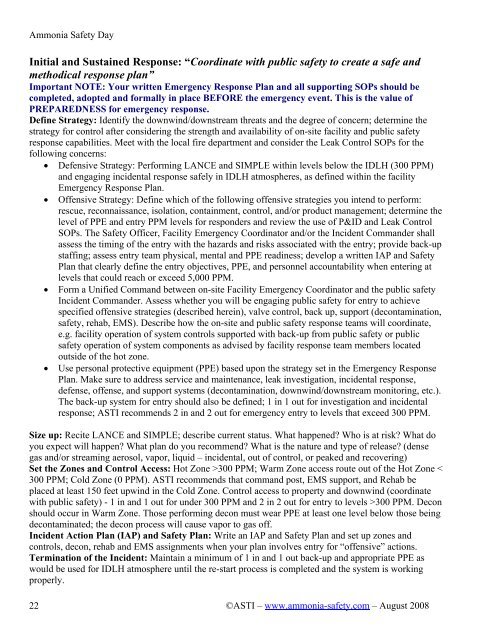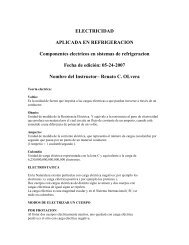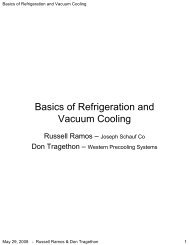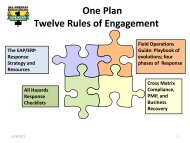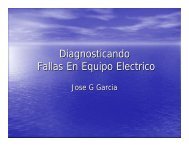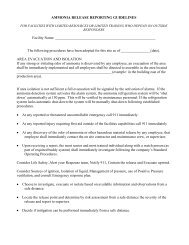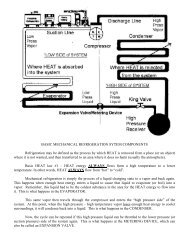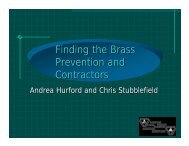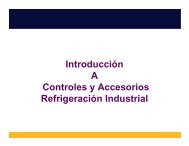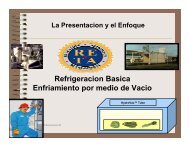Awareness Training Goals - Salinas Valley Ammonia Safety Day
Awareness Training Goals - Salinas Valley Ammonia Safety Day
Awareness Training Goals - Salinas Valley Ammonia Safety Day
You also want an ePaper? Increase the reach of your titles
YUMPU automatically turns print PDFs into web optimized ePapers that Google loves.
<strong>Ammonia</strong> <strong>Safety</strong> <strong>Day</strong><br />
Initial and Sustained Response: “Coordinate with public safety to create a safe and<br />
methodical response plan”<br />
Important NOTE: Your written Emergency Response Plan and all supporting SOPs should be<br />
completed, adopted and formally in place BEFORE the emergency event. This is the value of<br />
PREPAREDNESS for emergency response.<br />
Define Strategy: Identify the downwind/downstream threats and the degree of concern; determine the<br />
strategy for control after considering the strength and availability of on-site facility and public safety<br />
response capabilities. Meet with the local fire department and consider the Leak Control SOPs for the<br />
following concerns:<br />
• Defensive Strategy: Performing LANCE and SIMPLE within levels below the IDLH (300 PPM)<br />
and engaging incidental response safely in IDLH atmospheres, as defined within the facility<br />
Emergency Response Plan.<br />
• Offensive Strategy: Define which of the following offensive strategies you intend to perform:<br />
rescue, reconnaissance, isolation, containment, control, and/or product management; determine the<br />
level of PPE and entry PPM levels for responders and review the use of P&ID and Leak Control<br />
SOPs. The <strong>Safety</strong> Officer, Facility Emergency Coordinator and/or the Incident Commander shall<br />
assess the timing of the entry with the hazards and risks associated with the entry; provide back-up<br />
staffing; assess entry team physical, mental and PPE readiness; develop a written IAP and <strong>Safety</strong><br />
Plan that clearly define the entry objectives, PPE, and personnel accountability when entering at<br />
levels that could reach or exceed 5,000 PPM.<br />
• Form a Unified Command between on-site Facility Emergency Coordinator and the public safety<br />
Incident Commander. Assess whether you will be engaging public safety for entry to achieve<br />
specified offensive strategies (described herein), valve control, back up, support (decontamination,<br />
safety, rehab, EMS). Describe how the on-site and public safety response teams will coordinate,<br />
e.g. facility operation of system controls supported with back-up from public safety or public<br />
safety operation of system components as advised by facility response team members located<br />
outside of the hot zone.<br />
• Use personal protective equipment (PPE) based upon the strategy set in the Emergency Response<br />
Plan. Make sure to address service and maintenance, leak investigation, incidental response,<br />
defense, offense, and support systems (decontamination, downwind/downstream monitoring, etc.).<br />
The back-up system for entry should also be defined; 1 in 1 out for investigation and incidental<br />
response; ASTI recommends 2 in and 2 out for emergency entry to levels that exceed 300 PPM.<br />
Size up: Recite LANCE and SIMPLE; describe current status. What happened? Who is at risk? What do<br />
you expect will happen? What plan do you recommend? What is the nature and type of release? (dense<br />
gas and/or streaming aerosol, vapor, liquid – incidental, out of control, or peaked and recovering)<br />
Set the Zones and Control Access: Hot Zone >300 PPM; Warm Zone access route out of the Hot Zone <<br />
300 PPM; Cold Zone (0 PPM). ASTI recommends that command post, EMS support, and Rehab be<br />
placed at least 150 feet upwind in the Cold Zone. Control access to property and downwind (coordinate<br />
with public safety) - 1 in and 1 out for under 300 PPM and 2 in 2 out for entry to levels >300 PPM. Decon<br />
should occur in Warm Zone. Those performing decon must wear PPE at least one level below those being<br />
decontaminated; the decon process will cause vapor to gas off.<br />
Incident Action Plan (IAP) and <strong>Safety</strong> Plan: Write an IAP and <strong>Safety</strong> Plan and set up zones and<br />
controls, decon, rehab and EMS assignments when your plan involves entry for “offensive” actions.<br />
Termination of the Incident: Maintain a minimum of 1 in and 1 out back-up and appropriate PPE as<br />
would be used for IDLH atmosphere until the re-start process is completed and the system is working<br />
properly.<br />
22<br />
©ASTI – www.ammonia-safety.com – August 2008


